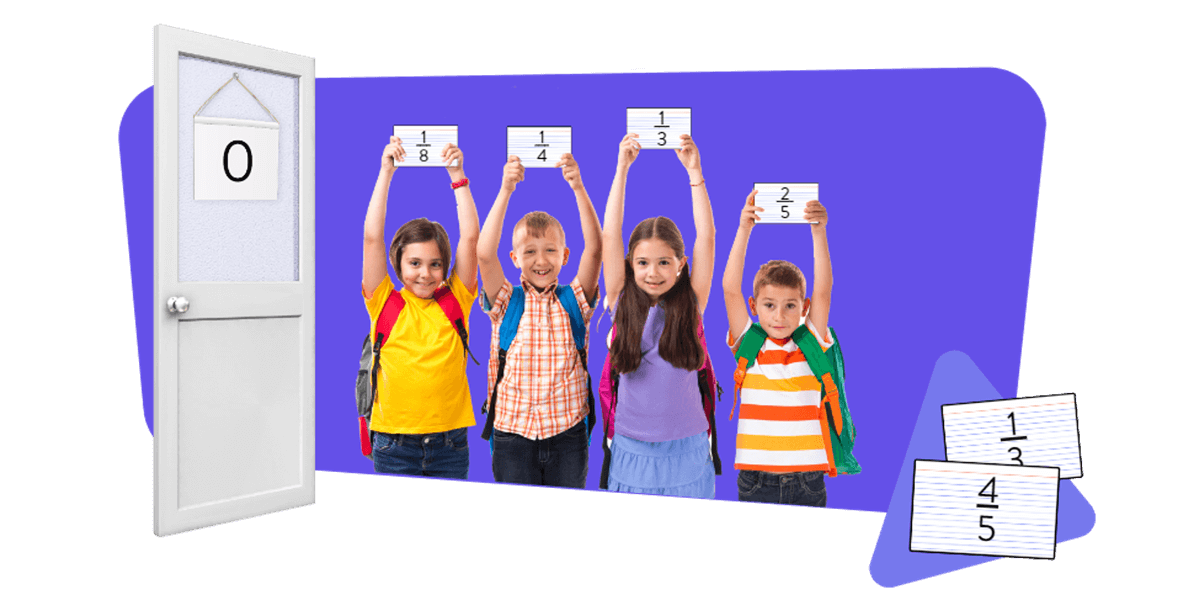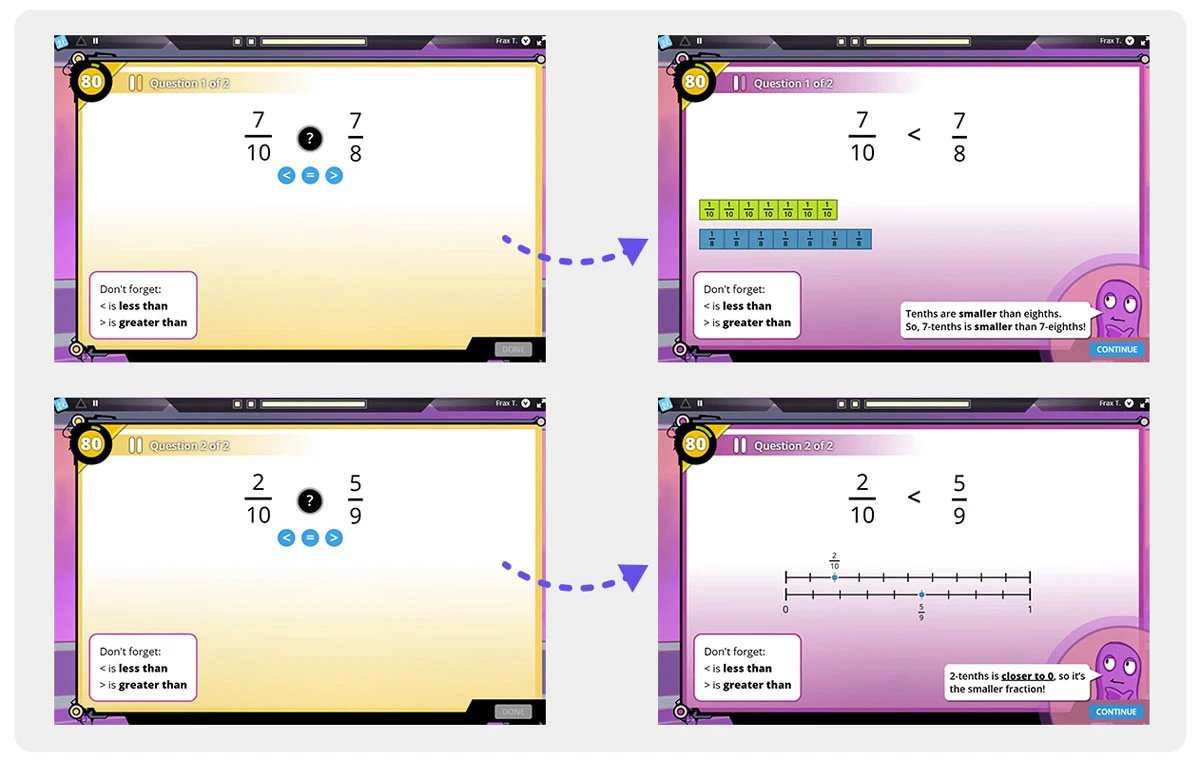
Understanding fractions can be challenging for both students and adults. What does the numerator represent? How can I visualize different fractions? How can I make something that seems abstract more concrete? With effective and engaging strategies, fraction help can be possible for all!
Creative tips to teach fractions to kids
You may be wondering how to teach fractions in new ways. No matter your curriculum or textbook, incorporating fun and effective fraction strategies can amplify your lessons to deepen understanding and help students view fractions in a new light.
Fraction basics: The fraction foundation for students
When teaching fractions, it’s critical to help students develop a conceptual understanding of concepts in the early years since knowledge of fractions significantly impacts students’ algebra and advanced math performance. Students who learn fractions with a firm grasp of fraction number sense (understanding that fractions are numbers that can be rewritten in different forms) will be much better prepared than students who rely solely on memorized procedures. Part of this strong number sense is an understanding of fraction magnitude (size), which in turn allows students to reason with and about fractions in various contexts.
Common questions about teaching fractions (and solutions)
What is a fraction? What does the denominator represent? How do we find equivalent fractions? There are lots of questions surrounding the concept of fractions. The most important one is about how to teach fractions to kids. When searching for effective ways to teach fractions, look for fraction teaching methods that reinforce that fractions are numbers and not some scary new concept.
What is the best way to introduce fractions?
Don’t wait for your fractions unit to introduce fractions. They’re just numbers, after all, so don’t isolate fractions in a single unit. Incorporate fractions with a tool like Frax and let your students start practicing before your fractions unit.
What strategy is most recommended for teaching fractions?
According to educational research, number lines are the most effective instructional representation of fractions, and curricula are increasingly emphasizing them. However, number lines are often tricky for students. It’s critical to offer students a lot of time and practice with creating and reading fractional representations.
ExploreLearning Frax takes the confusion out of the number line and helps students (grades 3+) build robust fraction skills in a remarkably small amount of time. Students work with fractions as numbers in an intuitive setting as they associate a fraction’s value with the length of a block model.
What are some common mistakes students make with fractions?
Mistakes happen when learning new things. There are a few common mistakes that make fractions challenging for students, including:
- Confusing the numerator and denominator as separate whole numbers.
- Failing to find a common denominator when adding or subtracting fractions.
- Not finding a common denominator.
- Not simplifying fractions to their lowest terms.
- Not understanding the meaning of the denominator.
- Misinterpreting mixed numbers.
How can you engage students in fractions?
Students are always looking for the fun in learning. Game-based learning is an engaging way to help students develop a strong understanding of fractions. With Frax, students develop mastery of fractions as they progress through carefully scaffolded story-driven missions. Fun features like customization, engaging offline materials, and more keep students engaged with fractions.
4 engaging strategies to teach fractions
Are you looking to make your fractions unit more effective and engaging? Try these strategies to teach fractions and make fractions for kids more meaningful.
1. Foster an understanding of fraction magnitude
A particular aspect of fractions that impacts subsequent learning is fraction magnitude. Students must adequately understand fraction magnitude in order to accurately compare fractions and perform other operations like adding and subtracting fractions.
Fraction magnitude knowledge begins when students view fractions as numbers. It's important to emphasize the value, meaning, and length of unit fractions early and often, just as you would when teaching students to count whole numbers. Help your students learn fractions and develop magnitude understanding by teaching them how a numerator and a denominator work together to create a single value (length).
But this practice doesn’t have to be boring! Incorporate physical manipulatives (like fraction blocks, cubes, bars, or tiles) to introduce students to basic fractions and help them view fraction magnitude for themselves. You can also show pictures of fractions in the real world and have students contribute their own examples to increase personal connections.
2. Incorporate visual representations, like length models and number lines
Research shows that as modeling tasks become more complex, fractions are easier to understand when presented with length models (blocks and number lines) rather than area models (such as circles, rectangles, and 1D shading). The strongest student success occurs when using number lines as the primary representation tool.
Understanding fractions can be much more intuitive for students when they use visual representations like length models and number lines. Help students become familiar with number lines by focusing their attention on intervals, rather than tick marks. Model how to count the intervals between 0 and 1, and teach students to associate that number with the denominator. Then, show students how to count the intervals between 0 and a particular point and associate that number with the numerator. Take engagement up a level with candy number lines or shaving cream desktop practice!
3. Get students moving
Fractions for kids can be fun and engaging when you incorporate movement in the classroom. Infuse movement-based activities to introduce a new skill or check for understanding at the end of a lesson. Your students can even create their own human number line to practice comparing fractions!

4. Use game-based tools
Develop fractions foundations while bringing students the challenge and interactivity they crave. Built on evidence-based practices, Frax uses intuitive visual representations (like length models) to introduce the number line representation of a fraction. Throughout Frax, students actively strengthen their fraction number sense as they complete games devoted to number line understanding, including locating fractions on a number line and even estimating their location.
With Frax, fractions no longer feel like work but a fun, interactive adventure where students actively experience success! Frax missions are structured as game-based challenges, allowing students to learn by doing as they progress through carefully scaffolded tasks. Using adaptive learning, enticing visuals, customization, tokens for effort and progress, and more, Frax engages students every step of the way on their road to success in fractions. There’s more fun coming soon with Frax Competitions where classrooms in the same building can engage in a friendly rivalry while learning!

Continue fractions learning in and out of the classroom with Frax
Teaching fractions on a number line can be traditionally difficult in a class-wide setting. Frax eliminates these barriers through individualized practice that uses the number line as the central representation tool. After a few short hours of Frax, students develop great familiarity and comfort with fractions on a number line. This serves as a springboard to more complex learning, eliminating the continuous confusion that is so well-known to teachers.
With Frax, you can reinforce concepts and assess student learning with a robust collection of offline activities. Captain's Checkpoints provide additional practice with skills from Frax missions. These collaborative, discourse-rich activities allow students to talk about fractions, verbalize their reasoning during problem-solving, and discover new strategies from peers. Frax also includes Quick Checks. These printable, brief questions help check for understanding and are perfect for exit tickets, task cards, or prompts for math discussions.
Frax also saves you time and energy with reporting features to monitor and celebrate student growth, along with professional development and digital learning communities. And the results are powerful! In a qualitative study, elementary teachers found that Frax increased test scores and learning, and students were more engaged and excited about math.
Frax just got even more fun!
Introducing Frax Competitions! Compete with other classrooms in your school and watch motivation soar. This new feature lets students face off with other classes in their school to stay engaged and build fraction skills.
Boost math achievement with Frax
Frax’s teaching strategies are founded on the latest educational research and proven to help students build a deep conceptual understanding of fractions. Focused on what works, a growing body of rigorous efficacy research shows that Frax positively impacts student learning, and can build the foundational understanding of fractions students need for ongoing math success in just 13 hours.
A recent study showed that Frax boosted math achievement for third graders. Students who used Frax were significantly more likely to achieve grade-level proficiency by the end of third grade, regardless of their starting achievement levels. In fact, 49% of students who were one grade level below their peers at the end of grade 2 achieved proficiency in grade-level math standards by the end of grade 3 when they used Frax.
“I love that Frax uses multiple models to help the students conceptually understand fraction magnitude. It gives them a deeper understanding. A student told me ‘I really get fractions now!’ He was so excited because fractions have been a real struggle for him.”
Teacher, Colorado
